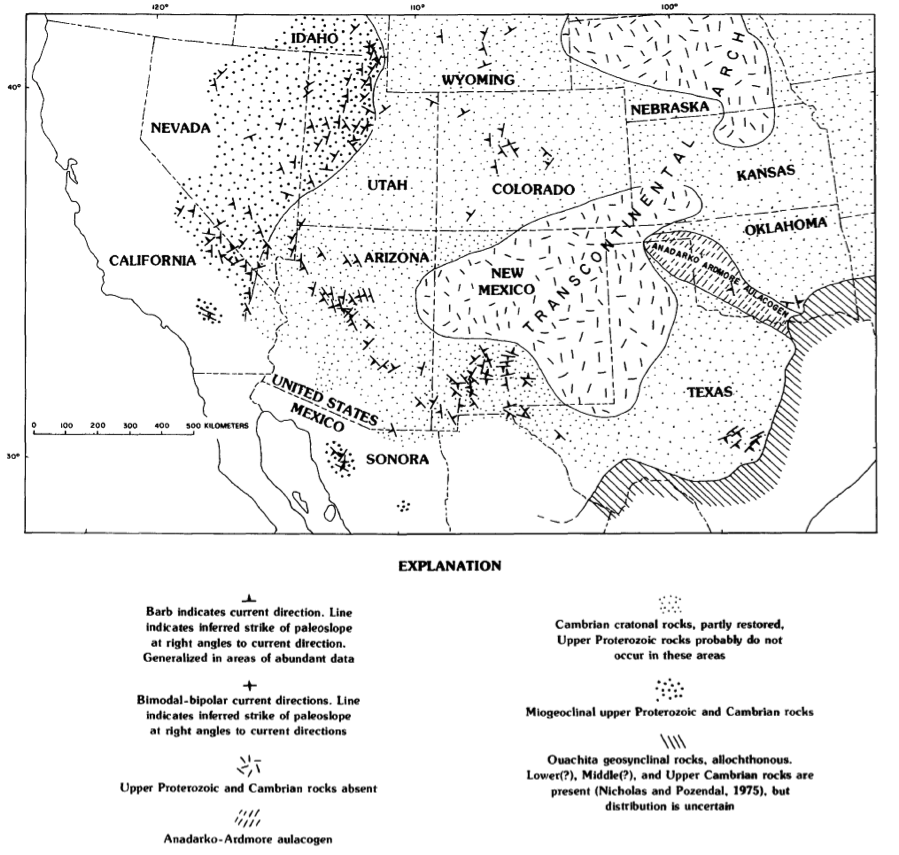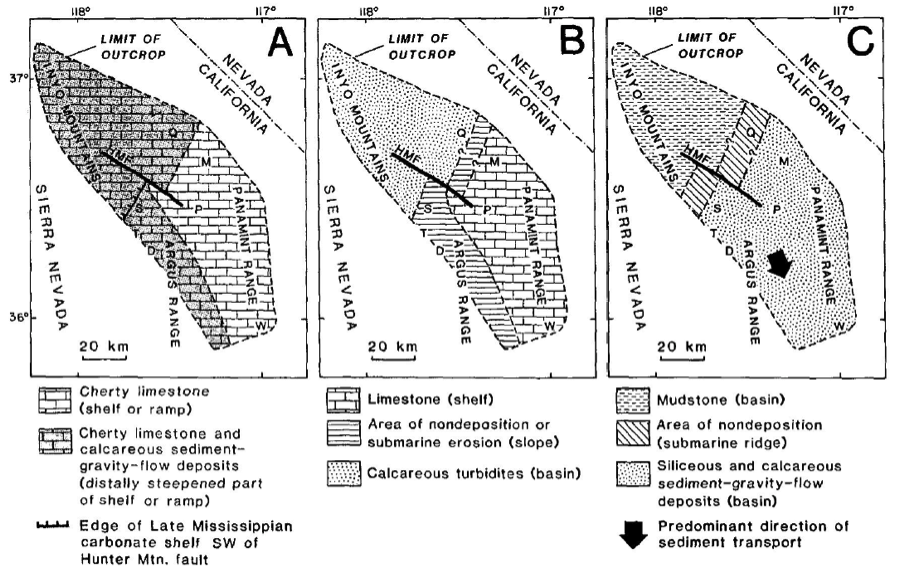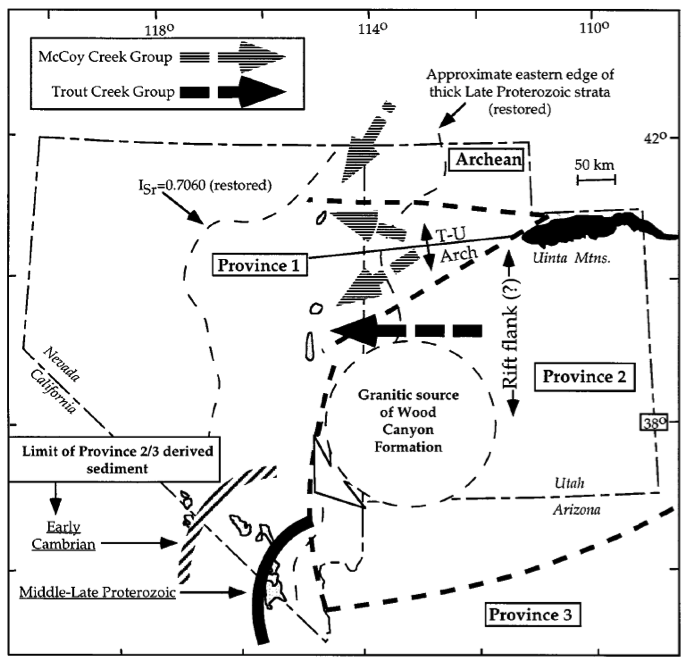
Jefferson Yarce
The hypothesis worked in this case is occurrence of paleocurrents, sediment source of sedimentary facies belts in the Cordilleran miogeocline during the late Precambrian to Early Paleozoic are not related to the “classic” North American margin. For this purpose, the research focused mostly in the eastern border of the Cordilleran clastic sequence for the time period mentioned above.
The Cordilleran miogeocline is defined with general agreement, as a sedimentary belt, extending from western Canada to northwestern Mexico covering much of current Idaho, Utah, Nevada and southern California (Figure 1 ) [Armin and Mayer, 1983]. The Cordilleran miogeocline represents a sedimentary sequence that was rifted during the Late Proterozoic to Middle Paleozoic, with a general continuity of lithofacies [Armin and Mayer, 1983; Stewart, 1988]. During this interval of time, the continental margin of North America is defined by the boundary between shallow water miogeosyncline and cratonal platform carbonate-siliciclastic rocks [Stewart, 1988].
 |
Figure 1 . Localization of current Cordilleran miogeocline. From Armin and Mayer (1983) |
Figure 2 shows paleocurrent patterns in the United States. The paleocurrent directions are variable across all the border, but it was found local general trends of directions westward in Idaho and Nevada, southwestward in Arizona, southwestward to southward in New Mexico and western Texas, and southward to southeastward in central Texas [Stewart et al., 1984]. In western Utah, most of the directions point to the west, which would suggest a N-S continental margin in the place where the Cordilleran miogeocline is locates. In southern Nevada and northwestern Arizona it is noted a continuity of paleocurrent directions across the cordilleran border. This interpretation would imply a non-exotic origin of the Cordilleran miogeocline.
 |
| Figure 2 . Paleocurrent directions [Stewart et al., 1984] |
From paleogeographic reconstructions based on lithofacies patterns, the facies indicated that the termination of the Cordilleran miogeocline belt to the west in California, is interpreted as a consequence of a southeast trending transform fault [Stone and Stevens, 1988]. This would suggest that the Cordilleran miogeocline can be attached to the western North American at least after the Middle Pennsilvannian (sediments to the east suggest the presence of a carbonate shelf formed at the North American margin). Figure 3 , shows lithofacies at both sides of the Hunter Mountain Fault (HMF) and indicates a continuity of facies at both sides of the fault interpreted to be the transform boundary at the western edge of the Cordilleran miogeocline. This is interpreted as the time when a significant tectonic event (the transform fault displacement) took place in the area.
 |
| Figure 3 . Pennsylvanian to Early Permian lithofacies and paleogeographic maps. (A) Morrowan and Atokan, (B) Desmoinesian to early Wolfcampanian, (C) Middle and late Wolfcampanian [Stone and Stevens, 1988]. |
For the Canadian Cordilleran Miogeocline to the north, the interpretation coming from a Nd isotopic study in sedimentary Neoproterozoic to Late Ordovician rocks, is that a derivation of sediments from the east is unlikely during the Paleozoic [Garzione et al., 1997]. However, sediments could have been transported from the Grenville orogen (~1000 Ma) to the western side of North America in the late Precambrian to Early Paleozoic. Neoproterozoic sedimentary rocks of Grenville origin, proximal to the western margin, could have been recycled into the miogeocline to produce the Grenville signature in the early Paleozoic [Garzione et al., 1997]. In conclusion, at least for the Canadian Cordillera miogeocline, the sediment source for the Proterozoic to Paleozoic rocks is probably coming from the east in North American margin. This is not consistent with the exotic origin proposed by [Hildebrand, 2009, 2013].
In a similar Nd isotopic study in the Great Basin (Nevada, Arizona and Utah), Farmer and Ball (1997) suggested that the source of sediments in the sediments were originated in a local basement source associated with a thermal bulge related with asthenospheric upwelling, this thermal adjustment uplifted the rifted side of the basin, generating subsequentely the local source pf sediments. This rift is considered that started around the Late Proterozoic to Early Cambrian time.
In Figure 4 , it is shown that after progressive and continued rifting, the margin was filled with sea water, and more inland source were coming to the Great Basin from the called Province 2 and 3 with an accumulation of sediments in the Early Cambrian miogeoclinal sedimentary rocks in the southwestern Great Basin. This is indicated by the McCoy Creek Group and Trout Creek Group arrows shown in the figure [Farmer and Ball, 1997].
 |
| Figure 4 . Late Proterozoic to Early Cambrian sediment distribution patterns in north-central and southwestern Great Basin as suggested by Nd isotope data [Farmer and Ball, 1997] |
Paleocurrents, lithofacies and Nd isotopes in the Cordilleran miogeocline and North American margin suggest an authoctonous origin of the sediments exposed in the Cordillera, deposited between the Late Precambrian and Middle Cambrian. The latter Nd isotope study also advocates for a rifted margin for the western United States, which is consistent with the classic North American margin interpretation.
REFERENCES
Armin, R. A., and L. Mayer (1983), Subsidence analysis of the Cordilleran miogeocline: implications for timing of late Proterozoic rifting and amount of extension ( USA)., Geology, 11(12), 702–705, doi:10.1130/0091-7613(1983)11<702:SAOTCM>2.0.CO;2.
Farmer, G. L., and T. T. Ball (1997), Sources of Middle Proterozoic to Early Cambrian siliciclastic sedimentary rocks in the Great Basin: A Nd isotope study, Bull. Geol. Soc. Am., 109(9), 1193–1205, doi:10.1130/0016-7606(1997)109<1193:SOMPTE>2.3.CO;2.
Garzione, C. N., P. J. Patchett, G. M. Ross, and J. Nelson (1997), Provenance of Paleozoic sedimentary rocks in the Canadian Cordilleran miogeocline: a Nd isotopic study, Can. J. Earth Sci., 34(12), 1603–1618, doi:10.1139/e17-129.
Hildebrand, R. S. (2009), Did Westward Subduction Cause Cretaceous – Tertiary Orogeny in the North American Cordillera ?, Geol. Soc. Am. Spec. Pap., 457, 1–71, doi:10.1130/2009.2457.
Hildebrand, R. S. (2013), Mesozoic assembly of the North American Cordillera, Geol. Soc. Am. Spec. Pap., 495, 1–169, doi:10.1130/2013.2495.For.
Stewart, J., M. McManamin, and J. Morales-Ramirez (1984), Upper Proterozoic and Cambrian rocks in the Caborca region, Sonora, Mexico — Physical stratigraphy, biostratigraphy, paleocurrent studies, and regional relations, United States Geol. Surv. Prof. Pap., 1309, 36.
Stewart, J. H. (1988), Latest Proterozoic and Paleozoic southern margin of North America and the accretion of Mexico, Geology, 16(2), 186–189, doi:10.1130/0091-7613(1988)016<0186:LPAPSM>2.3.CO;2.
Stone, P., and C. H. Stevens (1988), Pennsylvanian and Early Permian paleogeography of east-central California: Implications for the shape of the continental margin and the timing of continental truncation, Geology, 16(4), 330–333, doi:10.1130/0091-7613(1988)016<0330:PAEPPO>2.3.CO;2.